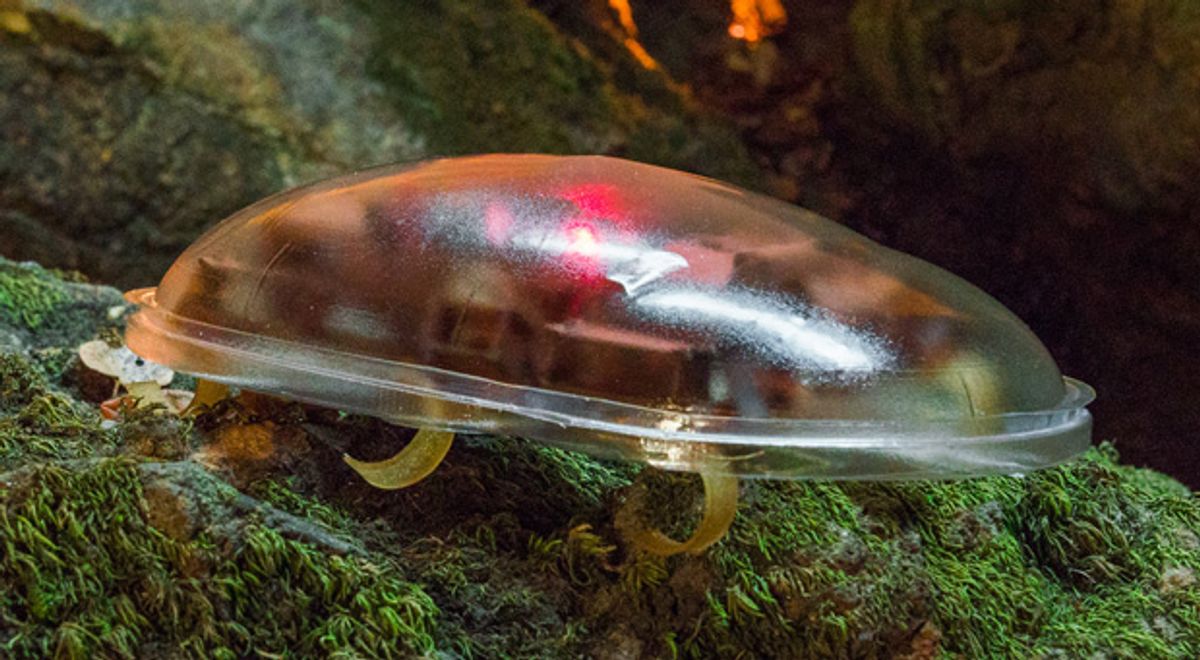Following along with the evolution of UC Berkeley’s RoACH robots has been absolutely fascinating. Since as far back as 2008, Ron Fearing’s Biomimetic Millisystems Lab has designed and redesigned their little robotic roaches with claws, wings, tails, any just about everything else that they could cram in there.
For a robot inspired by a roach, there’s been what seems like an obvious omission, and that's a shell. Robots have endoskeletons, rendering exoskeletons somewhat redundant, but do biologically constructed roaches have shells for reasons other than keeping their life goo inside? The answer is yes, and the Berkeley researchers have developed water and dust resistant armored shells that protect roachbots from impacts and elements while also allowing them to navigate through cluttered spaces.
First, let’s take a look at the process of outfitting VelociRoACH with a shell, made from a thermoplastic polymer sheet:
Not shown in the video is the water and dustproofing system, which is about as simple as it gets, being just a re-sealable zipper plastic bag with leg holes that fits inside the shells [right].

How does all this stuff work out? Pretty well, in fact: after a 5-minute frolic in a bath of poppy seeds (the granular test material of choice), no seeds made it into the robot’s inner workings. Three minutes of prancing through puddles showed that some drops could sneak through the zipper of the bag and the seals around the legs, and although the robot wasn’t adversely effected, the researchers suggest that it would do better being heat sealed in completely, improving the waterproofing but preventing reusability of the bag.
As for the shell itself, it was successfully able to protect the robot from multiple drops from four stories up, although the battery tended to disconnect and there’s currently no self-righting mechanism, which is unfortunate since the robot tends to fall through the air upside-down, being more aerodynamic in that direction.
Before we get to the other uses of a shell, I should mention that the paper (which is here, with Duncan Haldane as lead author) also discusses a bunch of other awesome stuff (too much to cram into this article), including how to rapidly fabricate arrays of tiny claws, force sensors, and strain gauges for roachbots. And most important, all of the plans and instructions for building a low-cost roachbot of your own, OpenRoACH, are now available online and open source.
This picture reveals the secret to how roaches, both the biological kind and the robotic kind, can move through clutter: they just roll sideways. The videos show it pretty clearly:
This research was led by Chen Li, from UC Berkeley’s department of integrative biology, who described the cockroach’s roll maneuver as “a form of natural parkour.” Cockroaches favor this method for traversing clutter most of the time, and its effectiveness is directly correlated with the streamlined roundness of their shell. Li proved this by outfitting roaches with artificial shells that were rectangular and measuring how much it screwed them up.
The next step was to see whether a rounded shell could also help a square robot get through clutter, and it worked the same way with VelociRoACH: even though the shell made the robot wider, thicker, and heavier, by promoting roll, the robot was able to squeeze through places that it would otherwise get stuck. Interestingly, the rectangular shells made it easier for robots to go vertical and climb, suggesting that shell shapes could be adapted to different requirements.
What’s relevant about this research, as far as robotics is concerned, is this:
Our robot experiments demonstrated that, complementary to sensory feedback control and motion planning, challenging locomotor tasks such as obstacle negotiation could be accomplished by utilizing effective body shapes to interact with the environment without requiring sensors, computers, and actuators, often impractical for small robotic platforms.
In other words, you don’t need a robot that can sense and avoid if you have a robot that can just mindlessly (yet effectively) plow through stuff.
“Integrated Manufacture of Exoskeletons and Sensing Structures for Folded Millirobots,” by Duncan W. Haldane, Carlos S. Casarez, Jaakko T. Karras, Jessica Lee, Chen Li, Andrew O. Pullin, Ethan W. Schaler, Dongwon Yun, Hiroki Ota, Ali Javey, and Ronald S. Fearing (all from UC Berkeley) was published in the May edition of the Journal of Mechanisms and Robotics.
“Terradynamically Streamlined Shapes in Animals and Robots Enhance Traversability Through Densely Cluttered Terrain,” by Chen Li, Andrew O. Pullin, Duncan W. Haldane, Han K. Lam, Ronald S. Fearing, and Robert J. Full (all from UC Berkeley) was published in the June edition of Bioinspiration and Biomimetics.
Evan Ackerman is a senior editor at IEEE Spectrum. Since 2007, he has written over 6,000 articles on robotics and technology. He has a degree in Martian geology and is excellent at playing bagpipes.




